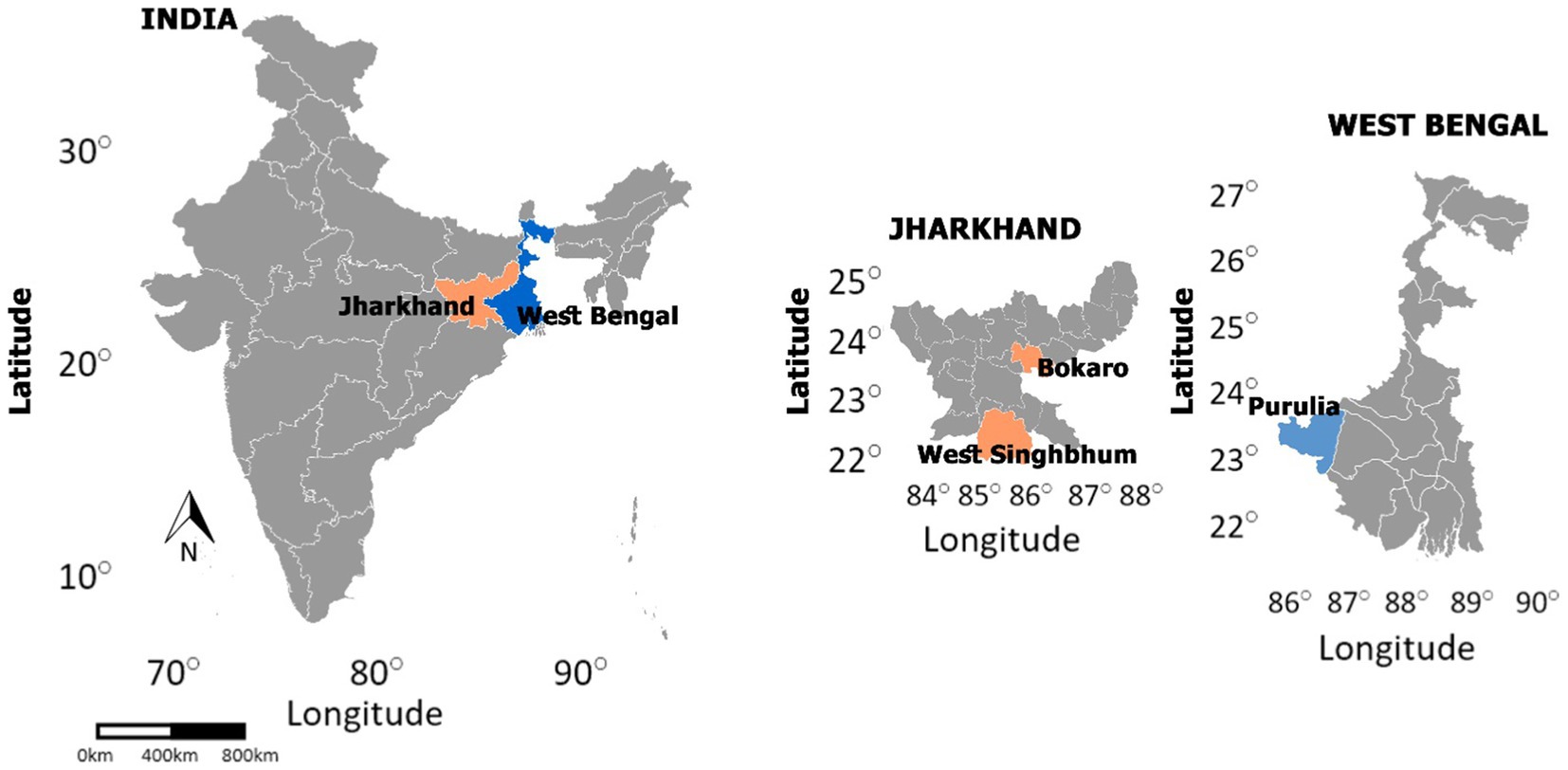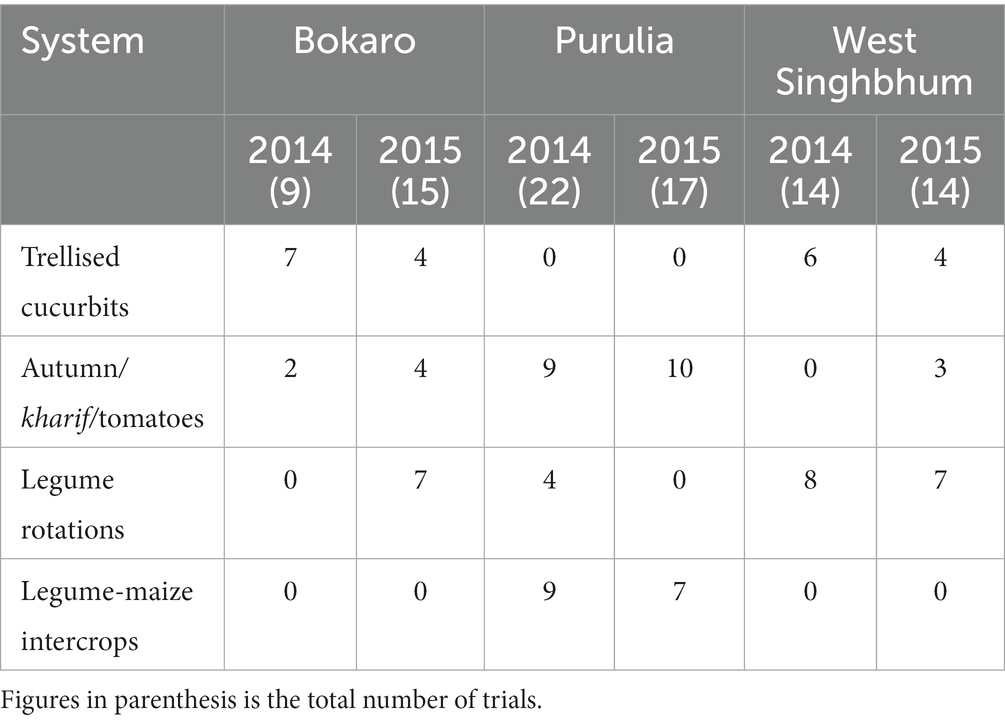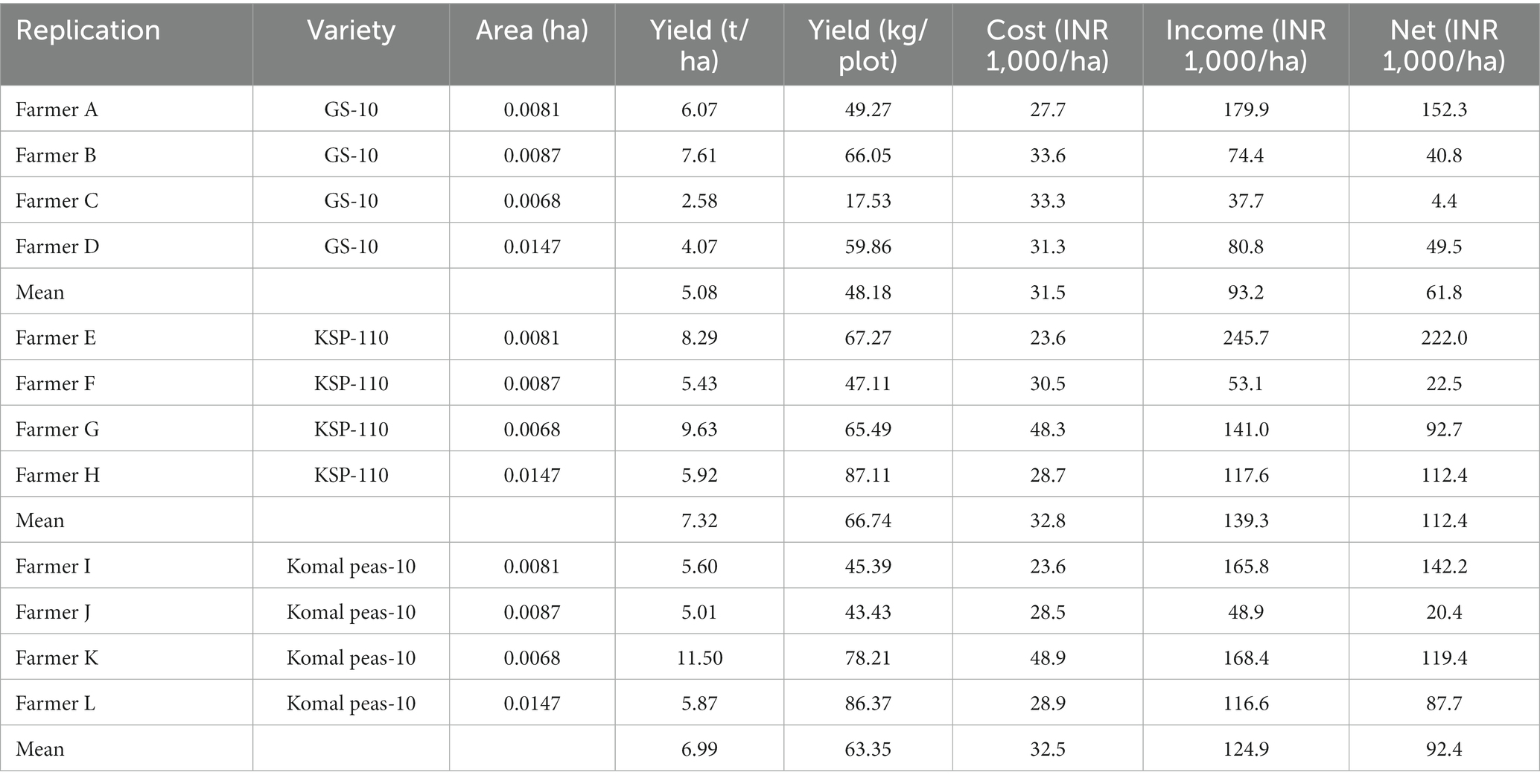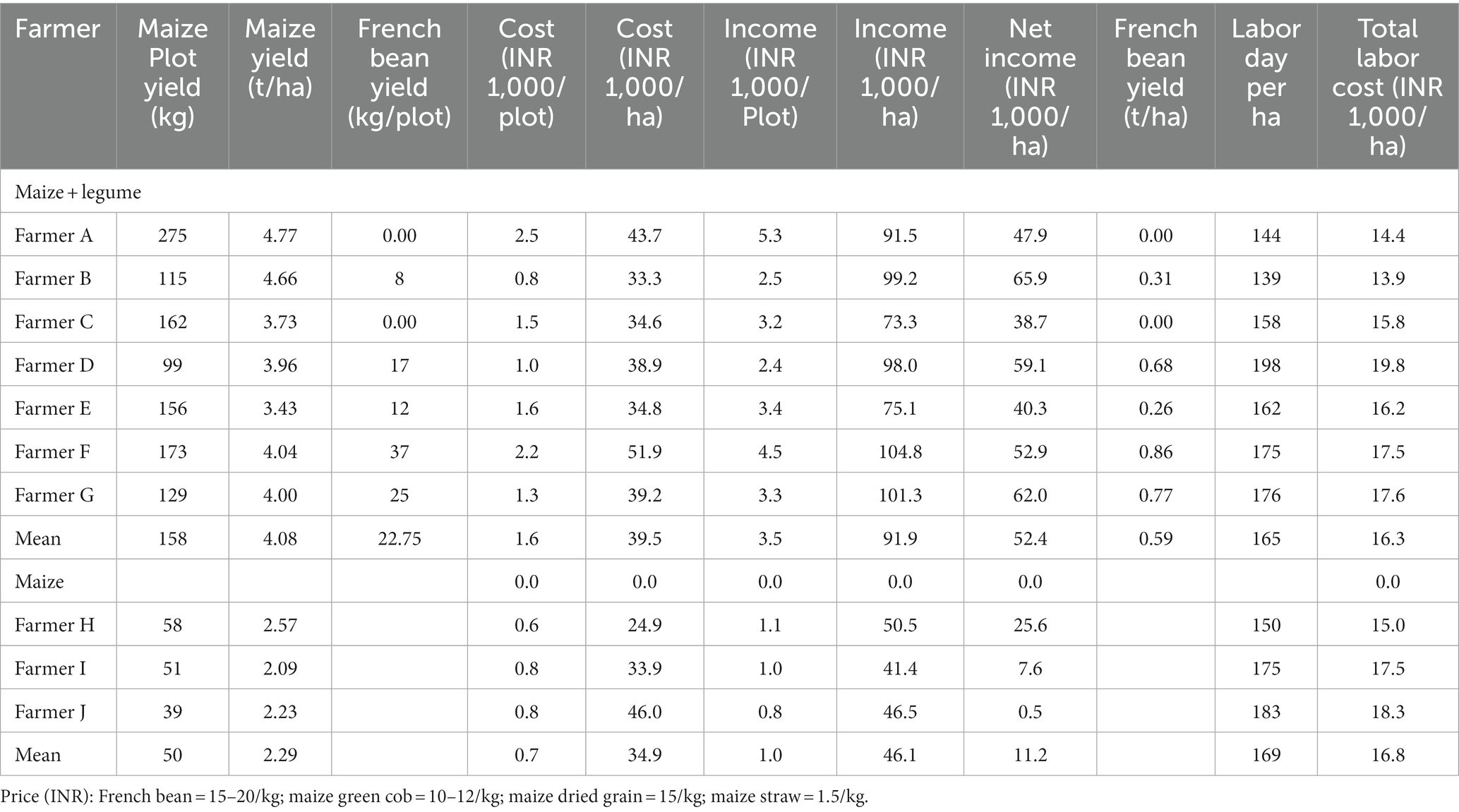- 1World Vegetable Center, South Asia/Central Asia, ICRISAT Campus, Hyderabad, Telangana, India
- 2International Crops Research Institute for the Semi-Arid Tropics, Hyderabad, Telangana, India
- 3School of Agriculture, Food and Wine, The University of Adelaide, Glen Osmond, SA, Australia
- 4Global Change Institute, The University of Queensland, St Lucia, QLD, Australia
- 5Professional Assistance for Development Action (PRADAN), Ranchi, Jharkhand, India
- 6TRIF-Transforming Rural India Foundation, Ranchi, Jharkhand, India
Failure of the rice crop, or low rice yield has dire consequences for rice-dependent households, including food insecurity and malnutrition, for India’s poorest farmers in the East Indian Plateau region. Crop diversification could reduce the risks of rice production from the vagaries of rainfall and provide cash income which is not generated from subsistence rice. Being the primary household laborers women bear the brunt of these difficult conditions in patriarchal societies. For this reason we engaged with the women farmers in Bokaro and West Singhbhum in the State of Jharkhand, and Purulia in West Bengal who participated in experiments conducted with vegetable crops and legumes in the upland and medium uplands where the traditional crop is broadcasted paddy rice. We explored four different vegetable systems, (i) cucurbits (rainy/kharif) (season—June to September), (ii) growing tomatoes in the “off season” (rainy season—July to October), (iii) growing legume crops in rotation with direct sown rice (dry/rabi season—November to January), and (iv) intercropping beans with maize (rainy season—June to September). The results showed that all the above crops proved much better in terms of income to the farmers, return per person day, although the input cost varied it was higher with the new systems explored. The research with the small-holding women farmers enabled them to try new options and make informed decisions about these opportunities. This study showed that farmers can increase crop diversity and expand the area sown to non-paddy crops. The farmers are now looking for new crops where the demand exceeds the supply. Importantly this study has demonstrated that the direct involvement of communities’ in research enables the farmers to sustainability explore solutions to the future problems with limited support from the external agencies.
Introduction
The largest concentration of people living in poverty in India are on the East India Plateau (EIP, Mitra, 2017). Here, in the State of Jharkhand, the Multidimensional Poverty Index is 0.44 compared to 0.28 for India overall and a staggering 75% of Jharkhand citizens live in poverty. It is no coincidence that this region is also home to many indigenous communities and to social unrest, due in part to Naxalite-Maoist insurgency (Dixit, 2010; Kumar, 2015) fed by marginalized, disenfranchised indigenous rural poor (Shah, 2007; Gomes, 2015). Most villagers on the EIP are food insecure with only 50–60% of their food grain requirement being met through on-farm production. This results in emigration by family members, particularly young males, causing on-farm labor shortages and social upheaval (Shah, 2006). These drivers contribute to widespread malnutrition, low literacy, particularly among girls, and limited access to medical services due to low household disposable income. Women play a central role in rural life on the EIP, not only do women carry the unborn child and breast feed newborn, they are the primary labor in agriculture, prepare family meals, grow nutrient dense food (vegetables, fruit, small livestock) and generate cash income.
India as a whole is characterized by sharp gender disparities and all the tribal societies in the study area are patriarchal with males making decisions about farming activities (Das and Tarai, 2011), but for these to be carried out by women who have little say in farm management even though they do most of the tedious farm work, cook for the family, clean the house and look after the children (Farnworth and Hutchings, 2009). Despite several economic, political and social changes, women are still far behind and held back by growing food rather than cash crops (Bhasin, 2007). There is widespread malnutrition, low literacy, particularly among girls, and limited access to medical services due to low household disposable income. Tribal women are particularly vulnerable to malnutrition (Kshatriya and Acharya, 2016). Despite their central role, gender inequality and discrimination leave many women disempowered and many now regard the empowerment of women as the key to improving nutrition (Debnath and Bhattacharjee, 2016), the largest contributor to poverty in the region.
The East Indian Plateau comprises much of the state of Jharkhand and parts of adjoining West Bengal, Bihar and Orissa. The region is characterized by high but variable rainfall (1,100–1,600 mm, 80% June–September), with frequent and sometimes long dry spells within the monsoon, little irrigation (~8% of area), high runoff and soil erosion, terraced mono-cropped paddy lands and subsistence agriculture. The main monsoon (kharif) crop is rice (overwhelmingly so for the poorer farmers), with generally very small areas of pulses, oilseeds and maize. Where rabi (post monsoon) crops are grown, they are typically fully irrigated crops of rice, vegetables, wheat, pulses and oilseeds. However, rabi cropping is very much limited by a lack of irrigation resources and by uncontrolled grazing by village cattle and goats and rainfed rabi crop yields are generally low (rice <2 t/ha, pulses <0.5 t/ha).
Historically rice is grown in the lowest parts of the landscape, but with increasing population pressure much of the original hillslopes have also been terraced and bunded over time to create medium-lowlands and medium-uplands for rice growing (Cornish et al., 2015) and up to 80% of the rice area is terraced and bunded “medium uplands.” However, uplands are often degraded and make little contribution to overall productivity. Failure of the rice crop, or low rice yield can have dire consequences for households, including food insecurity, malnutrition and distressed migration of men, to look for employment opportunities elsewhere (Keshri and Bhagat, 2012). There is little mechanization on the EIP, seeds of crops are generally hand-broadcast, weeds are removed by hand, and fertilizers (if used) are hand-broadcast. Despite the high rainfall, the region is characterized by frequent and sometimes long dry spells during the monsoon, and low rainfall at critical nursery and transplantation stages which causes complete crop failure in rice (Cornish et al., 2010; Cornish et al., 2015). In Jharkhand, rice production is overwhelmingly carried out under rainfed conditions (>90% of the area) making it vulnerable to these fluctuations in rainfall.
In addition to an unreliable rice harvest, crop diversity in Jharkhand is very low with 84% of the food crop area under cereals and only 7% under pulses. Jharkhand produces a little less than half of its food grains requirement and as a result, per capita food grain availability, including pulses (13–14 gm), has been 230 gm against 523 gm for all-India and below the minimum requirement of 480 gm/day (Singh, n.d.). There is thus a dire need to increase crop diversity to reduce the reliance on a risky rice crop and improve nutritional outcomes.
Crop diversification could reduce the risks of rice production and provide cash income which is not generated from a rice monoculture. This might lead to reduced seasonal migration for off-farm work and improve diet and health outcomes of the community. A lack of cash crops, highly priced vegetables, and insufficient income to purchase diverse nutritious vegetables leads the community to collect a few leafy vegetables from waste land. These are typically dried and used with rice (Ravishankar et al., 2015), particularly in the rainy season. Crop diversification in rice-based systems, especially with vegetables (Birthal et al., 2015), has been recognized as an effective strategy for fulfilling the objectives of enhancing productivity, food security (Kleinhenz et al., 1996; Panda, 2014) and nutrition (Rajendran et al., 2017), with judicious use of resources for marginalized farmers (Singh, 2010). The upland regions are quite suitable for kharif (monsoon) pulses such as pigeon pea (Cajanus cajan), urdbean (Vigna mungo), mungbean (Vigna radiata) and horse gram (Macrotyloma uniflorum). Slightly lower in the landscape, the “medium land” is suitable for rabi (winter) pulses like chickpea (Cicer arietinum), lentil (Lens culinaris), and garden pea (Pisum sativum). Low land is generally vacated after the harvest of transplanted rice during the 2nd week of December to the 2nd week of January when there remains some residual soil moisture (Cornish et al., 2015).
While crop diversification through the inclusion of high-value crops by broadening the base of the cropping system utilizes various techniques, such as inter-cropping/mixed cropping and other efficient management practices (Dalal and Shankar, 2022), such studies have typically been conducted without farmer involvement and may not be viable or have effective paths for adoption by communities. To improve the adoption of research outcomes, reduce food insecurity and poverty, and improve the livelihoods of women, we worked alongside tribal women farmers and helped them to explore vegetable crop options to try and diversify their own food production, increasing household nutrition and potentially cash incomes. The farmers experimented with vegetable crop options in upland and medium upland landscapes in 2014 and 2015 during the monsoon season (June to September) with support from the project team, and these were compared to the risks and opportunities of their traditional rice crops. It was thought that alternate crops to rice which require less water and can survive under variable rainfall conditions might be a highly valuable adjunct to rice in medium and upland regions.
Materials and methods
Geographic and cultural setting
We focused on three districts, Bokaro and West Singhbhum in the State of Jharkhand, and Purulia in the far west of West Bengal (Figure 1). While Purulia is on the EIP, much of West Bengal is not. Most of the area is covered with sandy loam to loam, acidic soils (pH 4.5–6.5) of low fertility. About 50% of soils are extremely to strongly acidic (pH <5.5). More than half of the soils in the region are low in available phosphorus (P), 18% low in potassium (K), 38% low in sulfur (S), and 45% are deficient in available boron (Petare et al., 2016). The water-holding capacity of soils in EIP are very low due to porous nature of the soil and undulating topography.
Approach to engagement
The project team worked with one women’s self-help group (SHG) comprising 25–40 women farmers at each of the three locations. The farmers were asked to highlight existing problems of farming (with rice) and for possible solutions (different methods of rice cultivation and alternatives to rice especially with vegetables). The discussion was facilitated by PRADAN (Professional Assistance for Development Action), an NGO that has been working effectively in the region for some time and staff from World Vegetable Center (WorldVeg). The primary objective was to help people in marginalized communities develop their own skills and initiatives, rather than delivering services or solutions to them. The women farmers learn through experience how to build their livelihoods and to access the information they need to engage effectively with government authorities and other people in power. The aim is for a systemic and positive change in the social, psychological and economic condition of the farmers so they can take charge of their lives and engage with the world around them. By providing a favorable environment for the discussions, options which were brought up by the farmers were critically evaluated by the group. The farmers in the group themselves decided on the options to evaluate in experiments. Many possible cropping systems were discussed in the SHG meetings, from which the following four cropping options emerged as favored by the women [trellised cucurbits, autumn (kharif) tomatoes, legumes in rotations and legume-maize intercropping], based on the feasibility to grow, water requirements, and local preferences including marketing.
The capacity of the farmers to conduct the research on their land was a function of their household risk profile and literacy which was discussed among the SHG. Initial support on the trial design and selecting control plots was provided by the project staff. Every month the farmers SHG met and discussed the progress and challenges and the options to mitigate these. Thus, the farmers conducted the research by themselves in a favorable environment with support from their peers and project staff. These experiments were conducted for 2 years (2013–2014 and 2014–2015), and each year the crops and the experiments to be conducted were decided by the farmers group, based on the previous season learnings. Project field staff trained capable farmers to record data such as the input costs, dates of cultural operations, hours of labor, harvesting, marketable and unmarketable yields, home consumption and price of the harvested products. Initially the project staff helped in recording and maintaining the data but the farmers then took on the data acquisition with supervision from project staff. The SHG women farmers were present during the data recording and all data were validated by the field staff.
The average household land availability for farming is less than 0.5 ha and spread across the upland, middle land and low land. Because it is quite wet, low land can be used only for paddy cultivation, thus upland and middle land were used for conducting trials ranging from 150 to 500 m2 (details in Table 1). The practices of the trials were approximately uniform but the experimental area depended on the farmer resources (land see Table 1) and labor. A village level research management committee was formed where the research famers, data collectors and SHG leadership were members. They meet every week for planning and review of progress. Apart from these meetings, frequent field visits were organized to observe and reflect upon the research activity. The research plots were treated as a learning resource for the whole community, farmers made observations and shared what the results meant to them. Any difficulty in implementation was shared in the weekly meetings and all required support was provided by the SHG. At the end of each crop season a reflection meeting was organized, where almost the whole village and the scientist along-with PRADAN team were present to share the observations and reflect on what are the learnings were and how it will influence the next season plans.

Table 1. Crop diversity of vegetables and cropping area from 2013 to 2015 during autumn (kharif) and winter (rabi) season across three research villages and farmers.
Field experiments
Tables 1 2 outline the four different crop diversification strategies explored, (i) cucurbits kharif season, June to September, (ii) growing tomatoes in the “off season” (monsoon), July to October, (iii) growing legume crops in rotation with direct sown rice (rabi season), November to January, and (iv) intercropping beans with maize (autumn/kharif/rainy season-June to September). In total 213 experiments were established by the farmers (Table 1).
The cucurbits and tomatoes were grown in traditionally rice grown fields as treatments along with the traditional rice for comparison. The intercropping of beans with maize was introduced in the sole maize grown land with sole maize as control plots. To utilize the soil residual moisture after the direct sown rice crop (due to early harvest of direct sown rice), legumes such as garden pea, French bean (Phaseolus vulgaris) and chickpea were introduced, otherwise the lands are not utilized for crops. The full details of the vegetable culture experimental methods are provided as Supplementary material, these are subservient to the experiments being used as a vehicle for farmer learning, empowerment and sharing of learnings among the women farmers.
An economic assessment of the production systems deployed was undertaken. The cost of cultivation was calculated by adding all input costs (field preparation, input supplies, trellising, irrigation, labor days at local prevailing cost etc.), and the net profit was calculated by deducting the total sales (including the family consumption) from the total cost incurred in the cultivation practice. The quantity of vegetables consumed in-house from the harvest also was recorded. We also assessed the economics of the typical practice of crop cultivation (mostly broadcasted paddy) as a nominal comparative control.
Economic analysis
A simple economic analysis was conducted for each of the enterprises. Labor (man days @ 8 h per day) was costed at the local village INR/day rate, including the family and the hired labor. The labor cost thus varied by village at the prevailing rate at the time of experiment. Trellising for vegetable production was costed at 3,000 INR for one tenth of an acre (0.04 ha). The trellis was assumed effective for 3 years for two crops per year for cucurbits, except for pointed gourd which is perennial, where one crop was harvested per year. The trellis cost was thus amortized across three subsequent years. The prices received for produce by each individual farmer was used to calculate income for each plot. Although rice is primarily used for home consumption, we have placed a value of 6.6 INR/kg (based on the production cost) for it so that it can rationally be compared with income from vegetable production or the opportunity cost for land and labor. Household consumption of vegetables and rice produced was included in the net income calculated.
Net Income (INR per plot) = Income (INR per plot) – Cost (INR per plot), includes the value of home consumption.
Income (INR per plot) = Sum of [marketable yield each harvest multiplied by selling rate (INR per kg)].
Cost (INR per plot) = All input costs (cost of seed+ fertilizer cost + pesticides cost + cost of agronomic practices+ cost of labor including family labor used for all the activities). The land rental value, depreciation cost, and interest on operating cost were not included as the primary aim is to analyze the incremental income from crop diversification with the similar land was used as control plot.
Statistical analysis
To test the significance of the rankings for each treatment, Kruskall-wallis non-parametric test (SAS v9.4, SAS Institute Inc., 2018) was performed for one- and two-way classified data, respectively, by using chi-square statistics. Multiple comparisons were done for significant factors.
Results
Cucurbits
The cultivation of cucurbit crops on trellises in the medium uplands provided a nominal eightfold increase in net income as compared to the traditional cultivation of paddy rice (Table 3). The cucurbit crop also contributed to diet diversification, as farmers consumed these vegetables at an average of 24 kg per family (Table 3, calculated based on the actual data on the vegetables consumed). Old trellises were used with minimum needed repairs. Pointed gourd was a new crop cultivated in this area and it provided the highest income from the unit area (0.04 ha) when compared to other vegetables (Table 4).
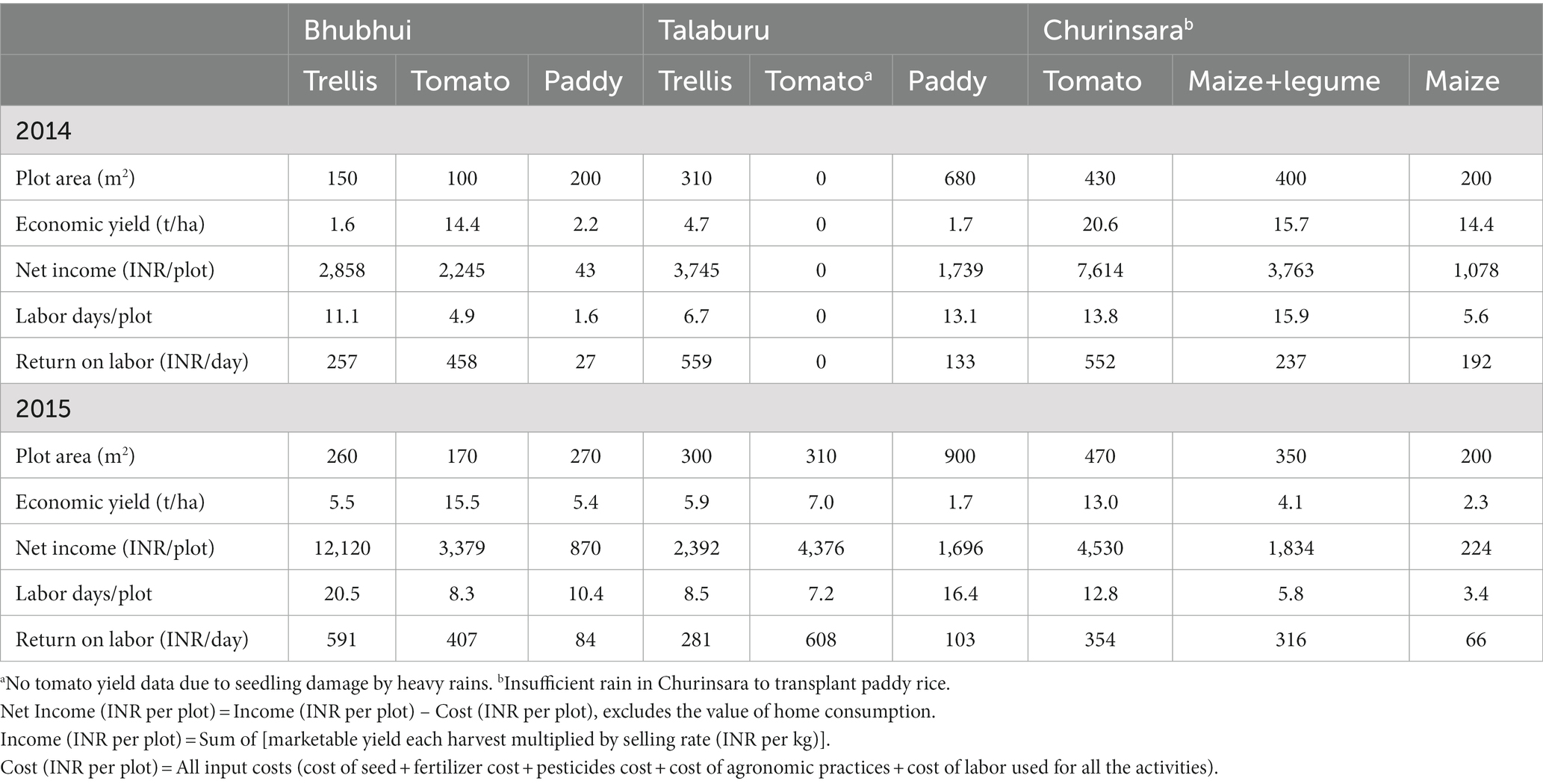
Table 3. Economics of trellis vegetable, traditional paddy and maize cultivation for 2014 and 2015 of Bhubhui, Talaburu, and Churinsaru villages.

Table 4. Vegetable consumption (kg/Household) before and after project intervention during autumn (kharif) season.
In the medium uplands (Table 5) the trellised cucurbits provided an almost sixfold increase in net income compared to the value of broadcasted paddy (traditional practice). It was observed that the bitter gourd crop had more fruit fly infestations than cucumber. Non-parametric tests showed that mean scores for cultivation of bitter gourd and cucumber on trellis have a greater net income (p > 0.11) compared to broadcasted paddy (Table 5B).
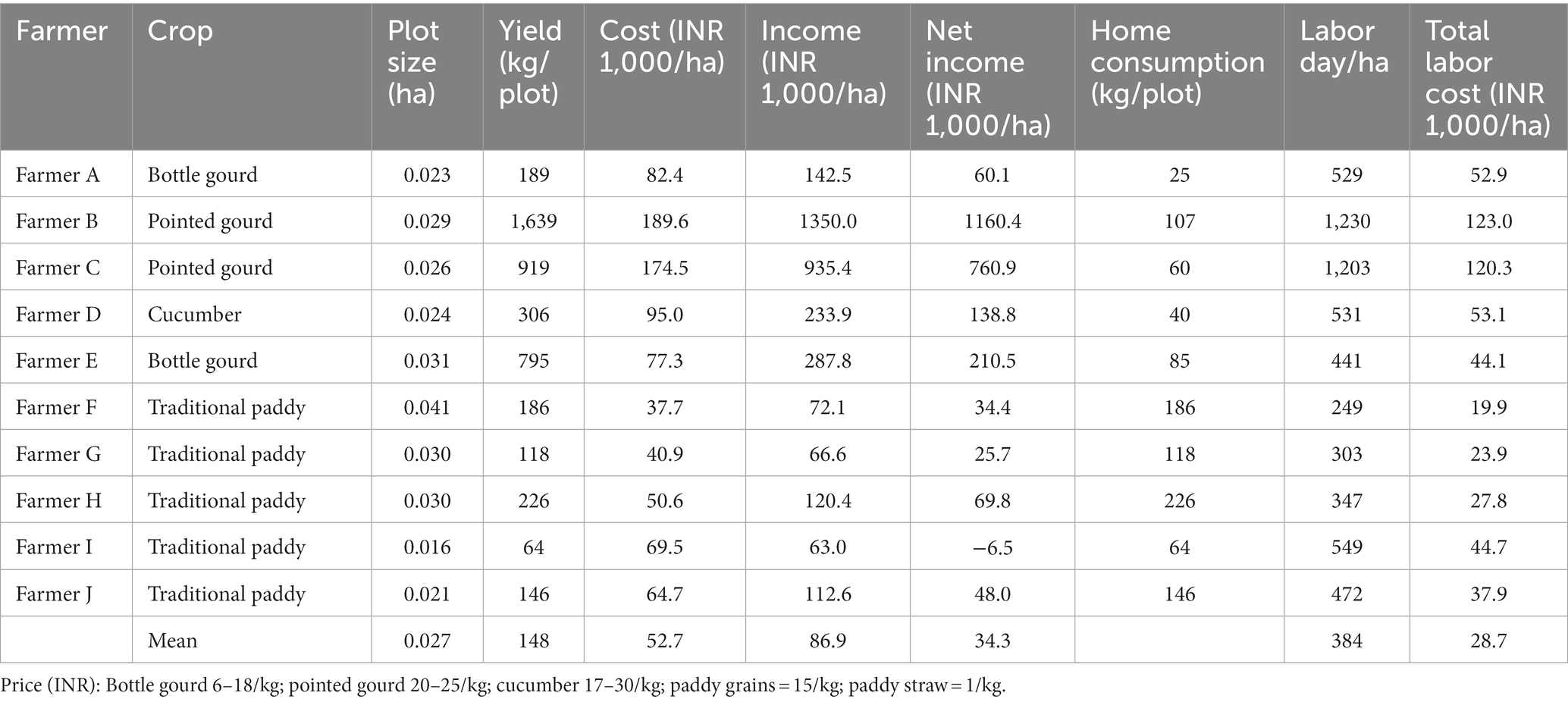
Table 5. Yield and income generated by cucurbits on trellis against traditional paddy in medium upland in Bhubhui village during autumn (kharif) 2015.
Even though cucurbit cultivation on trellises required 51% more labor and incurred 63% more labor costs than traditional paddy farming, the net income per ha was 93% higher from cucurbits compared to traditional paddy. The income per ha as well as net income obtained from the cultivation of cucurbits was significantly greater (p < 0.05) than from traditional paddy (Table 5A). Cucurbits also provided additional household nutrition as farmers consumed these vegetables on an average 63 kg per family over a 2–3-month period. Among cucurbits, pointed gourd was found to be the most profitable crop as it provided 86% more net income per ha than bottle gourd and cucumber. Owing to the perennial nature of pointed gourd, some farmers also obtained income from the same crop during the second or third year from the same crop.

Table 5A. Wilcoxon rank sum scores for income/ha and Net income/ha for cucurbits (all vegetables) on trellis against traditional paddy in medium upland in Bhubhui and West Singhbhum and village during autumn (kharif) 2015.
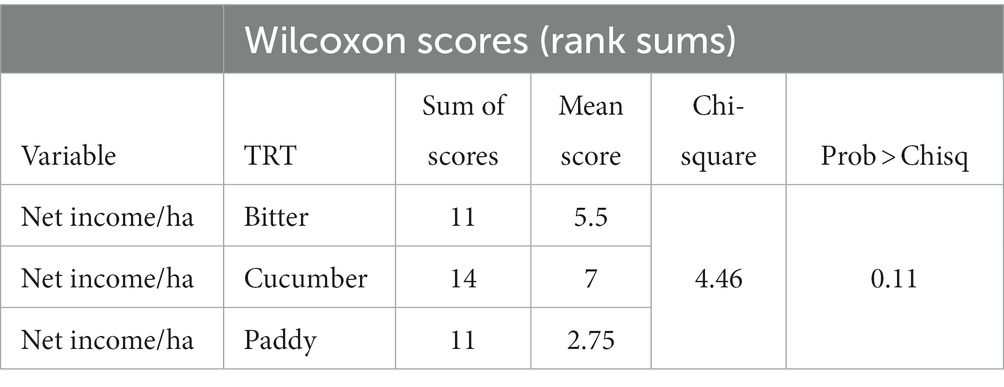
Table 5B. Wilcoxon rank sum of scores (Kruskal-Wallis test) for Net income/ha for vegetables (bitter gourd and cucumber) on trellis against broadcasted paddy in the medium uplands.

Table 6A. Wilcoxon (Kruskal-Wallis test) scores for yield t/ha and Net income/ha for tomato cultivation in upland in Churinsara during 2014.
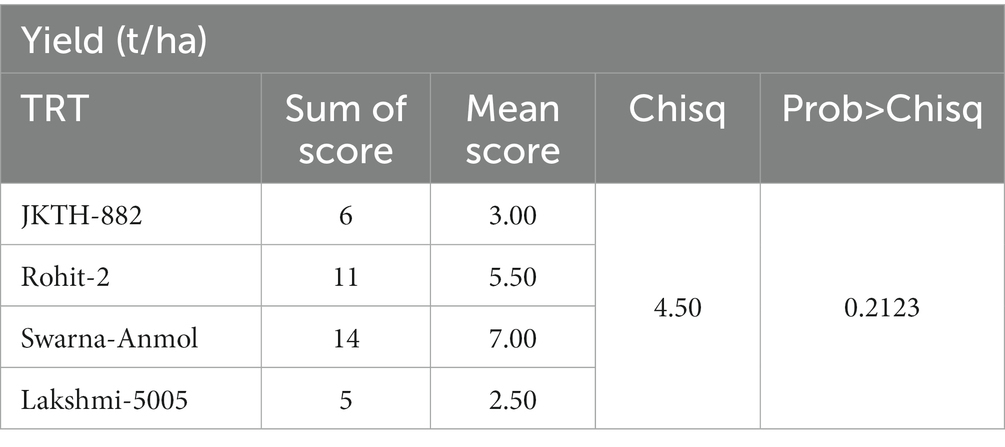
Table 6C. Wilcoxon (Kruskal-Wallis test) scores for yield t/ha for tomato cultivation in medium upland in Bhubhui during 2014.
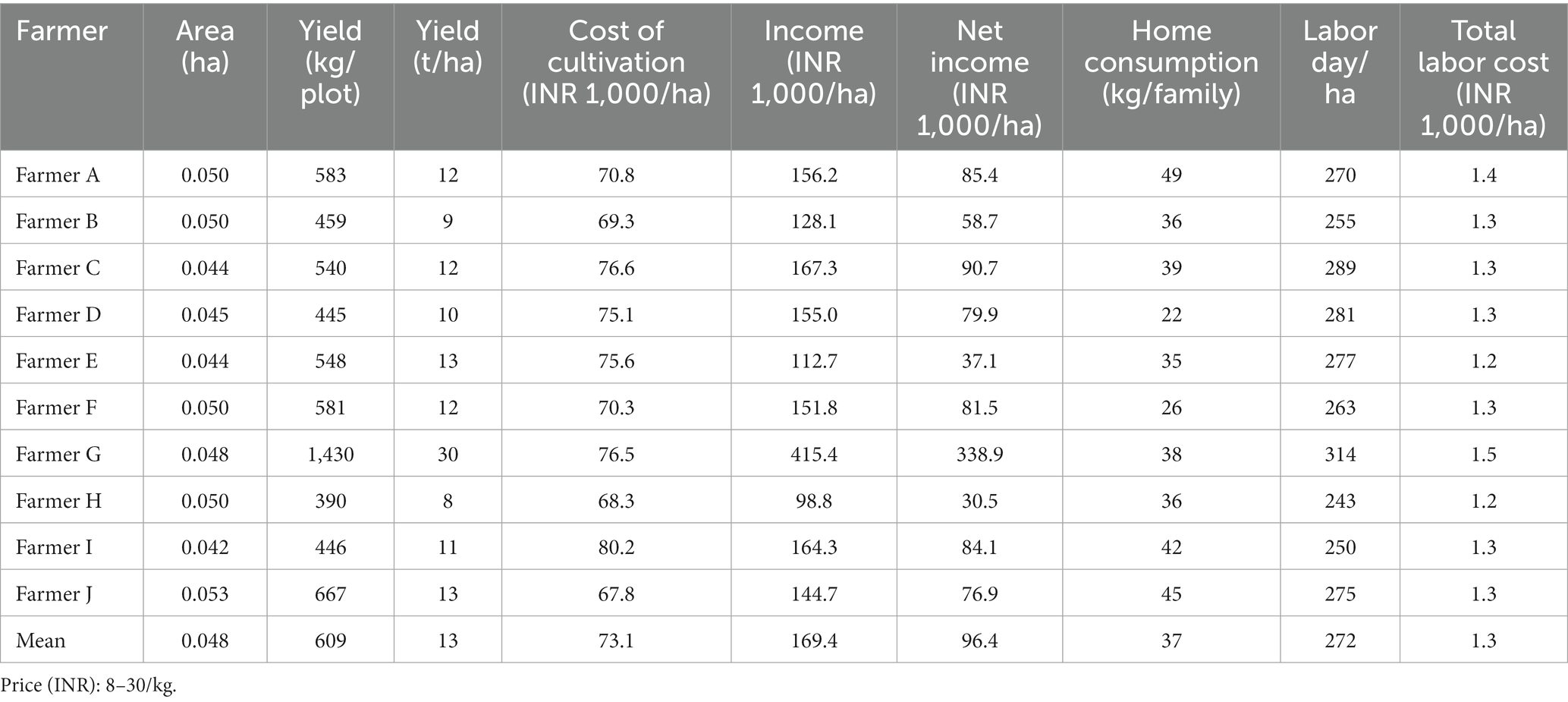
Table 6D. Yield and income generated by tomato cultivation in upland in Churinsara during autumn (kharif) 2015.

Table 6E. Yield and income generated by tomato cultivation in medium upland in Talaburu during 2015.
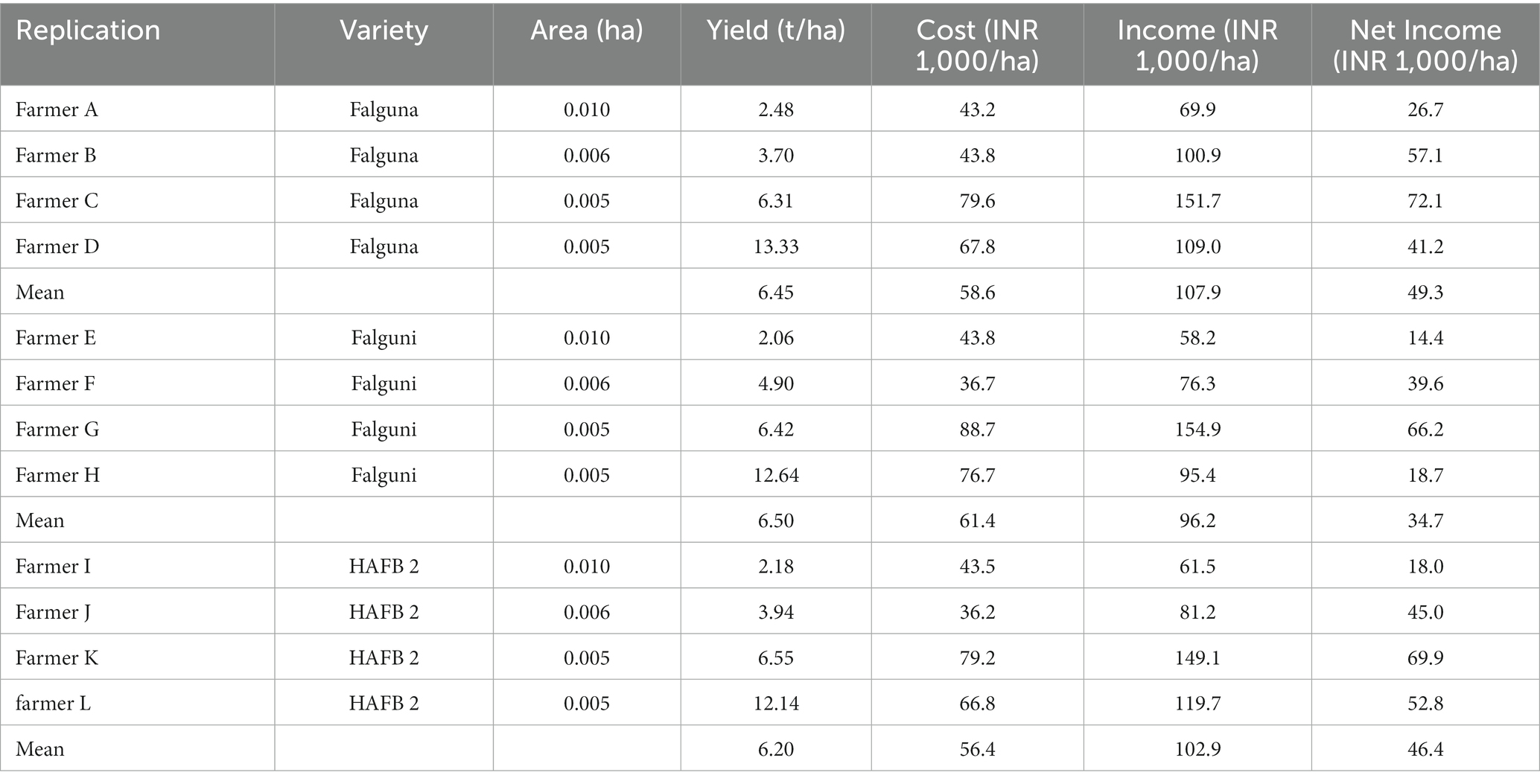
Table 7. Yield and income generated by French bean varieties in the medium lowlands in Talaburu during winter (rabi) season 2013–2014.

Table 7A. Wilcoxon (Kruskal-Wallis test) scores for Net income/ha for French bean varieties in the medium lowlands in Talaburu during winter (rabi) season 2013–2014.

Table 8A. Wilcoxon (Kruskal-Wallis test) scores for Yield t/ha and Net income/ha for garden pea varieties in the medium lowlands in Talaburu.
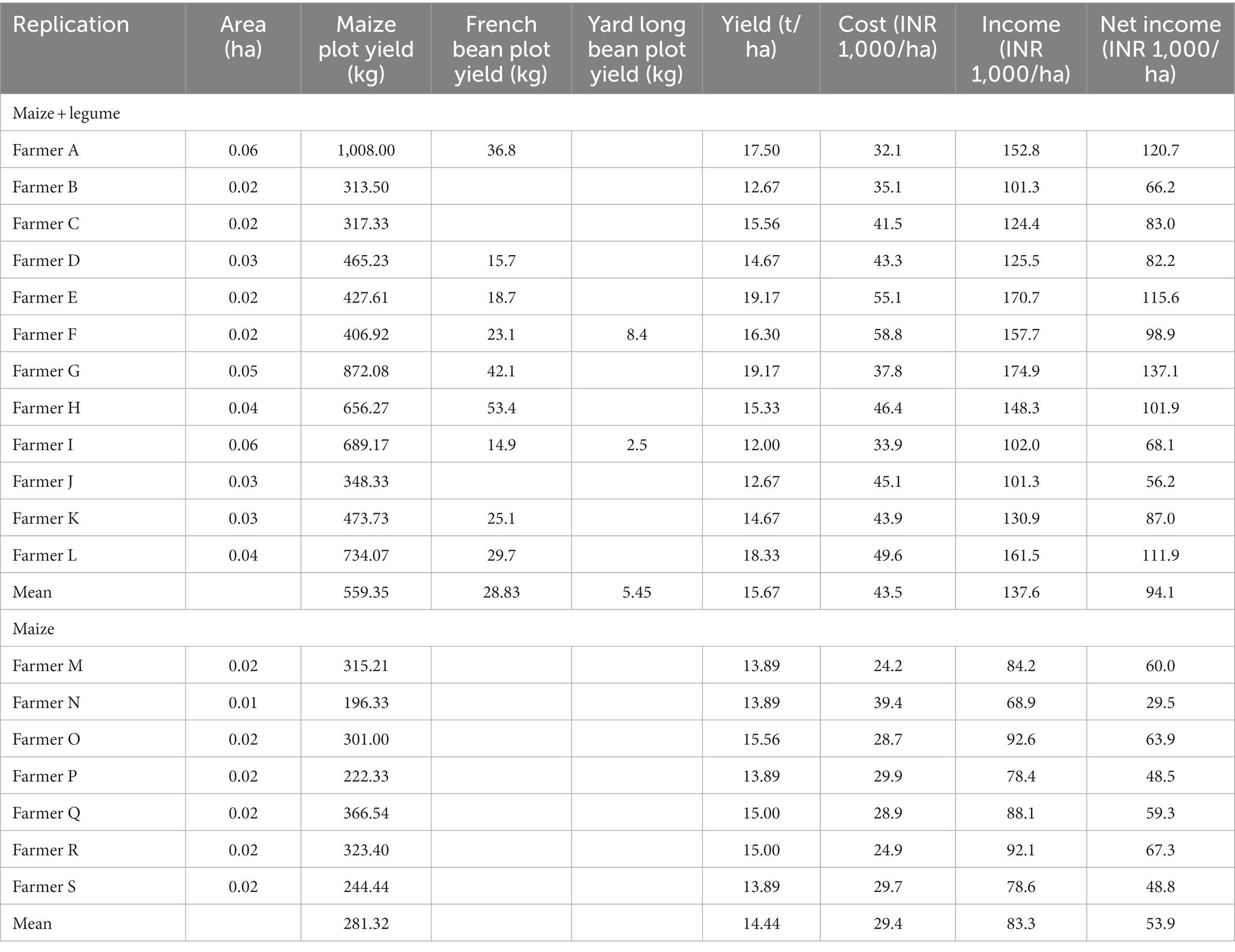
Table 9. Income generated from intercropping French bean and yard long bean with maize in Churinsara during 2014.

Table 9A. Wilcoxon (Kruskal-Wallis test) scores for Yield t/ha and Net income/ha for intercropping French bean and yard long bean with maize in Churinsara during 2014.

Table 9C. Wilcoxon (Kruskal-Wallis test) scores for Yield t/ha and Net income/ha for intercropping legumes with maize in Churinsara during 2015.
Cultivation of cucurbit crops on trellis in medium upland provided 76% increase in net income in West Singhbhum village (Table 5A). Among cucurbits, cucumber provided 48% more net income than bitter gourd (Table 6).
Out of season tomatoes
For kharif grown tomatoes in Churinsara in 2014 the yield of the most common variety (15.3 t/ha, Lakshmi-5005) was significantly different (p > 0.0009) from only one other variety, GS-600, which yielded very poorly due to its long duration and pest and disease infestations. Although some of the other varieties yielded slightly higher, the differences were not statistically significant (Figure 2). Nevertheless, differences in yield and variety translated into significant differences for net income (p > 0.0003) with varieties Swarma Anmol and Rohit-2 providing significantly greater income than the two lowest yielding varieties (GS-600 and Himraj, Table 6A).
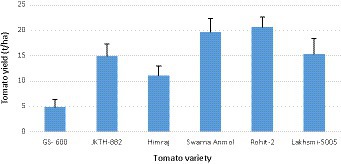
Figure 2. Yield of tomato varieties grown in the off (autumn/kharif season) season in Churinsara 2014 (error bars are the standard error of the mean for n = 9).
Four varieties, namely JKTH-882 (JK Seeds), Rohit-2 (Seminis), Swarna Anmol (ICAR) and Lakshmi-5005 (Nunhems), were evaluated for yields during the 2014 rainy season at Gola district (Table 6B). Swarna Anmol had the highest average yield (14.4 t/ha) and net income (307,571 INR/ha) followed by Rohit-2 which recorded a yield of 12.9 t/ha and an average net income of 265,981 INR/ha in two farmers’ fields. The yield increases of Swarna Anmol and Rohit-2 over the control Lakshmi-5005 was 63 and 46%, respectively, with an increase in net income of 101 and 74%, respectively. However, there was no significant difference between the varieties (p < 0.21) for yield (Table 6C). Besides improving their incomes, farmers also consumed tomatoes on an average of 1.5–6.5 kg per family.
Based on the results of varietal evaluation trials during the 2014 rainy season in Churinsara village of Purulia district of West Bengal (highest yield 20.63 t/ha and income were recorded from Rohit-2), farmers selected this variety for cultivation during kharif 2015. They obtained an average yield of 13 t/ha ranging from 8 and 30 t/ha and an average net income of 96,378 INR/ha (Table 6D) and in Talaburu, during the kharif season in 2015, the yield ranges from 5.7 to 10.6 t/ha with the mean yield of 7 t/ha and mean net income of 1,41,152 INR/ha (Table 6E).
Introduction of legume crops in rotation with paddy
Out of the three French bean varieties, Falguni (Seminis Seeds) yielded highest (6.5 t/ha) which is on par with the variety Falguna (Jagdish Seeds) (Table 7). While the average net income/ha obtained from Falguna is 41% higher than from Falguni, primarily due to a higher market preference due to its soft and fleshy pods, the non-parametric tests indicated that the differences between the varieties were not significantly different for net income (p > 0.47) (Table 7A).
In the case of garden pea (Table 8), KSP – 110 (Kalash Seeds Pvt., Ltd.) had the highest average yield of 7.32 t/ha and average net income of 112,424 INR/ha but, the non-parametric tests showed that there were no significant differences between the varieties for yield (p > 0.50) or net income (p > 0.67, Table 8A).
Intercropping legumes with maize
The farmers earned an average net income of 94,079 INR/ha by growing a legume intercropped with maize, 74% more than that of the average net income of seven comparable farmers growing maize as a sole crop (Table 9). Among the legume crops, French bean yields (0.72 t/ha) were greater than those of yard long bean (0.19 t/ha). The yield of the maize under intercropping also increased when compared to sole maize without intercropping due to better agronomic practices such as line sowing and associated weeding, and generally improved crop management in the intercrops (Table 9A).
In Purulia, West Bengal the intercropping of vegetable French bean (local variety) with maize varieties Kanchan 25 and Kaveri, were evaluated by seven farmers during the 2015 rainy season (Table 9B). Based on the experience of the previous year farmers selected French bean as the preferred intercrop. The farmers earned an average net income of 52,400 INR/ha which is 78% more than that of the average net income of the farmers (three) growing maize as a sole crop. Average yield of French bean was 0.59 t/ha as an intercrop. The yield of the maize under intercropping again increased by 44% when compared to sole maize. Labor use per hectare of land and labor cost per hectare were nearly same for both the cases but net income per ha were very different (p < 0.05). Income per ha INR 91,900 vs. INR 46,100 (p = 0.017) as well as net income, INR 52,400 vs. 11,200 (p = 0.017) obtained from the intercropping was significantly greater than from sole maize crop (Table 9C).
Discussion
Growing rainy season vegetables (cucurbits in trellis, tomatoes, legume maize intercropping and legumes in rotation with the paddy) in these three locations proved to be a promising and economic alternative. Growing cucurbits under a trellis system, especially cucumber, proved to be the better option. Although the initial investment is high in the case of cultivation of pointed gourd due to the cost of planting materials such as rhizomes or cuttings, and horizontal trellising is necessary, which adds to the production costs, the cost reduces in subsequent years due to the perennial nature of the crop which needs only maintenance in subsequent years. This crop also helps in promoting local entrepreneurship through raising the seedlings of pointed gourd locally and also helps other farmers to easily access pointed gourd seedlings. The farmers of Bhubhui village were interested in expanding the area of pointed gourd crops and began to produce seedlings from cuttings of pointed gourd in their village and sold these seedlings to neighboring villages at 10 INR/seedling. This was a somewhat unexpected outcome but illustrates the courage and empowerment of the farmers.
In the kharif season farmers of Churinsara village faced problems of water scarcity and little rains, and the rice crop failed. In this situation, income from tomato contributed significantly to their livelihood. Thus, diversifying into vegetables reduces risk and the catastrophe that comes from over reliance on subsistence rice (Cornish et al., 2015). In addition to cash income, farmers also consumed tomatoes on an average 37 kg per family, improving economic security, nutrition and health. Similarly, growing legumes, especially French bean as an intercrop with maize, helped the farmers with early income during the lean rainy season and helps them in continuing their livelihood to purchase inputs for other crops, especially paddy which will remain the major crop. Apart from that French bean added nutrition to the meal of the poor community as well created social harmony through its distribution among neighbors and relatives. The availability and affordability of vegetables during the rainy season is usually very limited for the tribal people of the study area and while no formal survey on household consumption of vegetables which farmers grew during the rainy season was conducted, at the commencement of the project, all of the farmers who were going to participate in the vegetable growing experiments were asked about the availability of vegetables for home consumption before the project intervention, specifically during the rainy season (kharif). Discussions with farmers and field staff revealed that vegetable availability increased significantly during the project intervention, either through their own production or by giving vegetables to neighbors without the need for purchase. This increase in availability corresponded with an increase in home consumption of vegetables. Although there have been a number of studies exploring crop diversity and diet diversity of smallholders in India (e.g., Chinnadurai et al., 2016; Anuja et al., 2020, 2022), these have essentially been meta-analysis of regional statistical data rather than the first hand observations evident in the present study.
Rotation of legumes with direct sown rice gives some additional income to the farmers, but the availability of the residual soil moisture is an issue as the soil water is rapidly exhausted. French bean and garden pea demanded more water compared to chickpea and thus legumes following rice might be more beneficial for farmers with some contingency irrigation (Mukherjee, 2015). Working directly alongside farmers, we have shown that vegetable production can provide an important and viable adjunct to paddy rice production, securing cash income and the ability to buy food when the rice crop fails, improving household diet diversity and nutrition and income to also purchase inputs for rice production or other essential family items such as health services. Many studies also reported increased income and profit by substituting vegetables in the paddy lands (Kleinhenz et al., 1996; Singh et al., 2022). A key element of this work has been the engagement of famers in the research activity which gives them the ability to continue to experiment and develop new systems within their own communities.
For the smallholder farmers of this region growing vegetables is comparatively difficult compared to the paddy, due to lack of knowledge of agronomic practices, more inputs required and risk of pest and diseases. These are perceived as main impediments during the process of introduction. Although more labor per unit land is required for vegetable production it has been found to be highly profitable, especially for families with smaller holdings and thus a higher labor:land ratio (Joshi et al., 2006; Birthal et al., 2015). In future, the occurrence of pests and diseases may increase due to area expansion and continuous cultivation of the vegetables. Since the farmers or the citizens have been involved in all the activities of research, we assume they have developed the capacity to identify solutions or alternatives through the internal and stakeholder linkages which were created as a platform by this project. Through the project the farmers were trained to mitigate the risk of growing the alternative crops. For instance, growing tomatoes during hot-wet season will be at risk of bacterial wilt and leaf diseases such as early and late blight. In that case, the farmers are able to contact the appropriate agencies to solve the problems, such as use of vegetable grafting with disease resistant rootstocks and scions to grow tomato in hot wet season. For cucurbits, the potential risk will be the fruit flies which can be managed by applying appropriate good agricultural practices including the fruit fly lures. This study and learnings by farmers will help them in trying not only vegetables but also newer crops with economic potential such as orchard crops, and plantation crops. The policies of the local government also influence the crop diversification with high value crops such as vegetables (Panda, 2014). Some studies also reported that the farmers shifting from growing vegetables to oilseeds due to the increased input and risk in growing vegetables (Singh et al., 2022).
However, while the agronomic and household nutrition results are very important and significant, given that agriculture remains the main livelihood in these communities, an even more important and significant aim was to explore how engaging farmers as partners in agronomic research could empower them and develop their capacity for solving problems. In this research the agronomic experimentation provides a highly relevant context for development of human capacity for local, independent innovation, aimed at improving livelihoods. The farmers were able to establish and conduct the experiments with sufficient rigor, supported by their peers in the SHG’s and the project staff. In doing so the farmers generated new knowledge and developed new skills, sufficient to assist in the solution of new problems which might arise in the future. Such participatory action learning in SHG’s with tribal women in the region has previously been shown to be effective in improving nutritional (Kadiyala et al., 2021) and health (Gope et al., 2019) outcomes for infants, but this appears to be the first time that such an approach has been successfully used by tribal farmers in India to conduct scientifically validated experiments. While only literate farmers were able to take and record measurements, substantial and effective peer to peer learning about the conduct of the research and the results were observed and discussed by all of the farmers in the SHG’s. It has been demonstrated many times that peer-peer learning is more effective for technology adoption among rural poor than traditional extension approaches (BenYishay and Mobarak, 2019; Takahashi et al., 2020). Even in these highly disadvantaged communities, is it possible that empowerment and agency, through active participation in research, widens the pathway out of poverty? Although similar types of participatory approaches have been used elsewhere in the world with disadvantaged smallholders to tackle environmental degradation in agriculture (Johnson et al., 2003) and rice culture (Stoop et al., 2009), these approaches are not always successful (Nederlof and Dangbégnon, 2007). Much of the success of the present project lay in the common goal of the project team and farmers as systemic and positive change agents in the social, psychological and economic condition of the women farmers so they could take charge of their lives and engage with the world around them. The adoption of this common goal was a key element in the success of the project, more so than the agronomic technologies.
Data availability statement
The original contributions presented in the study are included in the article/Supplementary material, further inquiries can be directed to the corresponding author.
Author contributions
RM, RMN, MU, and WB designed the study. DK and RM designed field sampling procedures, which were conducted by AK, BG and led by DK. AV and AR performed data analysis. RM, DK, and MU primarily wrote the manuscript with specific sections contributed by other authors. All authors contributed to the article and approved the submitted version.
Funding
This work was undertaken as part of the initiative “Improving livelihoods with innovative cropping systems on the East India Plateau” which was supported by the Government of Australia. It was also supported by long-term strategic donors to the World Vegetable Center: Taiwan, the Foreign, Commonwealth and Development Office (FCDO) from the UK Government, United States Agency for International Development (USAID), Australian Centre for International Agricultural Research (ACIAR) (LWR/2010/082), Germany, Thailand, Philippines, Korea, and Japan.
Conflict of interest
The authors declare that the research was conducted in the absence of any commercial or financial relationships that could be construed as a potential conflict of interest.
Publisher’s note
All claims expressed in this article are solely those of the authors and do not necessarily represent those of their affiliated organizations, or those of the publisher, the editors and the reviewers. Any product that may be evaluated in this article, or claim that may be made by its manufacturer, is not guaranteed or endorsed by the publisher.
Supplementary material
The Supplementary material for this article can be found online at: https://www.frontiersin.org/articles/10.3389/fsufs.2023.966376/full#supplementary-material
References
Anuja, A., Kumar, A., Saroj, S., and Singh, K. (2020). The impact of crop diversification towards high-value crops on economic welfare of agricultural households in eastern India. Curr. Sci. 118:1575. doi: 10.18520/cs/v118/i10/1575-1582
Anuja, A., Shivaswamy, G., Ray, M., and Singh, K. (2022). Pattern of crop diversification and its implications on undernutrition in India. Curr. Sci. 122:1154. doi: 10.18520/cs/v122/i10/1154-1160
BenYishay, A., and Mobarak, A. M. (2019). Social learning and incentives for experimentation and communication. Rev. Econ. Stud. 86, 976–1009. doi: 10.1093/restud/rdy039
Bhasin, V. (2007). Status of tribal women in India. Stud. Home Comm. Sci. 1, 1–16. doi: 10.1080/09737189.2007.11885234
Birthal, P. S., Roy, D., and Negi, D. S. (2015). Assessing the impact of crop diversification on farm poverty in India. World Dev. 72, 70–92. doi: 10.1016/j.worlddev.2015.02.015
Chinnadurai, M., Karunakaran, K., Chandrasekaran, M., Balasubramanian, R., and Umanath, M. (2016). Examining linkage between dietary pattern and crop diversification: an evidence from Tamil Naidu. Agric. Econ. Res. Rev. 29, 149–160. doi: 10.5958/0974-0279.2016.00042.2
Cornish, P. S., Karmakar, D., Kumar, A., Das, S., and Croke, B. (2015). Improving crop production for food security and improved livelihoods on the East India plateau. I. Rainfall-related risks with rice and opportunities for improved cropping systems. Agric. Syst. 137, 166–179. doi: 10.1016/j.agsy.2015.01.008
Cornish, P., Kumar, A., and Khan, M. (Eds.) (2010). East India plateau - basket case or future food basket? Food Security from Sustainable Agriculture: Proceedings of the 15th Australian Agronomy Conference. Lincoln: Australian Society of Agronomy.
Dalal, S., and Shankar, T. (2022). Crop diversification and its importance in agriculture: a review. Indian J. Nat. Sci. 13, 44540–44548.
Das, B., and Tarai, D. (2011). Decision-making and fertility behaviour: a comparative analysis of scheduled caste and scheduled tribe women in Odisha. Soc. Change 41, 233–249. doi: 10.1177/0049085711041002
Debnath, A., and Bhattacharjee, N. (2016). Understanding malnutrition of tribal children in India: the role of women’s empowerment. Ecol. Food Nutr. 55, 508–527. doi: 10.1080/03670244.2016.1223652
Farnworth, C., and Hutchings, J. (2009). Organic agriculture and women’s empowerment. Chicester: IFOAM.
Gomes, J. F. (2015). The political economy of the Maoist conflict in India: an empirical analysis. World Dev. 68, 96–123. doi: 10.1016/j.worlddev.2014.11.021
Gope, R. K., Tripathy, P., Prasad, V., Pradhan, H., Sinha, R. K., Panda, R., et al. (2019). Effects of participatory learning and action with women’s groups, counselling through home visits and crèches on undernutrition among children under three years in eastern India: a quasi-experimental study. BMC Public Health 19, 1–15. doi: 10.1186/s12889-019-7274-3
Joshi, P. K., Joshi, L., and Birthal, P. S. (2006). Diversification and its impact on smallholders: evidence from a study on vegetable production. Agric. Econ. Res. Rev. 19, 219–236.
Johnson, N. L., Lilja, N., and Ashby, J. A. (2003). Measuring the impact of user participation in agricultural and natural resource management research. Agric. Syst. 78, 287–306. doi: 10.1016/S0308-521X(03)00130-6
Kadiyala, S., Harris-Fry, H., Pradhan, R., Mohanty, S., Padhan, S., Rath, S., et al. (2021). Effect of nutrition-sensitive agriculture interventions with participatory videos and women’s group meetings on maternal and child nutritional outcomes in rural Odisha, India (UPAVAN trial): a four-arm, observer-blind, cluster-randomised controlled trial. Lancet Planet. Health 5, e263–e276. doi: 10.1016/s2542-5196(21)00001-2
Keshri, K., and Bhagat, R. B. (2012). Temporary and seasonal migration: regional pattern, characteristics and associated factors. Econ. Polit. Wkly. 47, 81–88.
Kleinhenz, V., Schnitzler, W., and Midmore, D. (1996). Diversification and transformation of Asian paddy rice fields to upland vegetable production. Plant Res. Dev. 43, 81–94.
Kshatriya, G. K., and Acharya, S. K. (2016). Gender disparities in the prevalence of undernutrition and the higher risk among the young women of Indian tribes. PLoS One 11:e0158308. doi: 10.1371/journal.pone.0158308
Kumar, S. S. (2015). Nonviolent measures to Deal with Naxalism in India: an assessment of Government’s response. Thammasat Rev 18, 84–101.
Mitra, S. (2017). Re-assessing “trickle-down” using a multidimensional criteria: the case of India. Soc. Indic. Res. 136, 497–515. doi: 10.1007/s11205-017-1568-6
Mukherjee, A. (2015). “Evaluation of the policy of crop diversification as a strategy for reduction of rural poverty in India” in Poverty reduction policies and practices in developing Asia. eds. A. Heshmati, E. Maasoumi, and G. Wan (Switzerland: Asian Development Bank and Springer International Publishing AG), 125–143.
Nederlof, E. S., and Dangbégnon, C. (2007). Lessons for farmer-oriented research: experiences from a west African soil fertility management project. Agric. Hum. Values 24, 369–387. doi: 10.1007/s10460-007-9066-0
Panda, R. K. (2014). “Trend and pattern of crop diversification in Odisha” in India studies in business and economics. eds. M. Ghosh, D. Sarkar, and B. Roy (New Delhi: Springer), 59–67.
Petare, K. J., Nayak, J., Jaini, V., and Wani, S. P. (2016). Livelihood system assessment and planning for poverty alleviation: a case of rainfed agriculture in Jharkhand. Curr. Sci. 110, 1773–1783. doi: 10.18520/cs/v110/i9/1773-1783
Rajendran, S., Afari-Sefa, V., Shee, A., Bocher, T., Bekunda, M., Dominick, I., et al. (2017). Does crop diversity contribute to dietary diversity? Evidence from integration of vegetables into maize-based farming systems. Agric Food Sec 6:50. doi: 10.1186/s40066-017-0127-3
Ravishankar, M., Kaur, D. P., Bhushan, K. B., and Easdown, W. J. (2015). Traditional leafy vegetables of a tribal community in Jharkhand, India. Acta Hortic. 43–52, 43–52. doi: 10.17660/actahortic.2015.1102.4
Shah, A. (2006). The labour of love. Seasonal migration from Jharkhand to the brick kilns of other states in India. Contrib. Indian. Sociol. 40, 91–118. doi: 10.1177/006996670504000104
Shah, A. (2007). “Keeping the state away”: democracy, politics, and the state in India’s Jharkhand. J. R. Anthropol. Inst. 13, 129–145. doi: 10.1111/j.1467-9655.2007.00417.x
Singh, R. D. (2010). “Food security for increasing rural livelihood under limited water supply through adoption of diversified crops and crop sequences” in Resource conservation Technologies for Food Security and Rural Livelihood. eds. A. R. Khan, S. S. Singh, R. C. Bharti, T. K. Srivastava, and M. A. Khan (Udaipur, India: Agrotech Publishing Academy), 342–355.
Singh, B. (n.d.) Status paper on rice in Jharkhand. Directorate of Rice Research. http://forest.jharkhand.gov.in/fresearch/admin/file/research_665.pdf (Accessed November 22, 2021).
Singh, P., Adhale, P., Guleria, A., Bhoi, P. B., Bhoi, A. K., Bacco, M., et al. (2022). Crop diversification in South Asia: a panel regression approach. Sustainability 14:9363. doi: 10.3390/su14159363
Stoop, W. A., Adam, A., and Kassam, A. (2009). Comparing rice production systems: a challenge for agronomic research and for the dissemination of knowledge-intensive farming practices. Agric. Water Manag. 96, 1491–1501. doi: 10.1016/j.agwat.2009.06.022
Keywords: cropping system, legumes, paddy, off-season, intercropping, citizen science
Citation: Manickam R, Kaur DP, Vemula A, Rathore A, Unkovich M, Bellotti W, Kumar A, Gorai B and Madhavan Nair R (2023) Diversifying vegetable production systems for improving the livelihood of resource poor farmers on the East Indian Plateau. Front. Sustain. Food Syst. 7:966376. doi: 10.3389/fsufs.2023.966376
Edited by:
Sendhil R, Pondicherry University, IndiaReviewed by:
Md Abdur Rouf Sarkar, Bangladesh Rice Research Institute, BangladeshMargiana Petersen-Rockney, University of California, Berkeley, United States
Copyright © 2023 Manickam, Kaur, Vemula, Rathore, Unkovich, Bellotti, Kumar, Gorai and Madhavan Nair. This is an open-access article distributed under the terms of the Creative Commons Attribution License (CC BY). The use, distribution or reproduction in other forums is permitted, provided the original author(s) and the copyright owner(s) are credited and that the original publication in this journal is cited, in accordance with accepted academic practice. No use, distribution or reproduction is permitted which does not comply with these terms.
*Correspondence: Ravishankar Manickam, cmF2aS5tYW5pY2thbUB3b3JsZHZlZy5vcmc=
 Ravishankar Manickam
Ravishankar Manickam Devender Pal Kaur1
Devender Pal Kaur1 Anilkumar Vemula
Anilkumar Vemula Murray Unkovich
Murray Unkovich Ashok Kumar
Ashok Kumar Ramakrishnan Madhavan Nair
Ramakrishnan Madhavan Nair